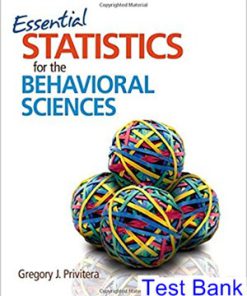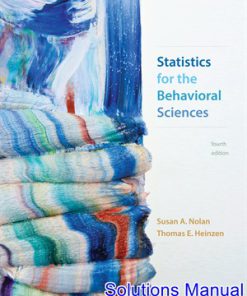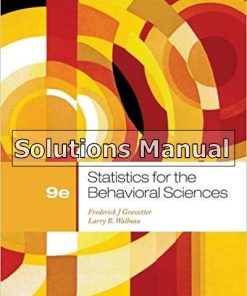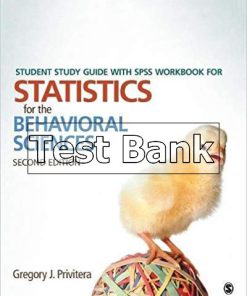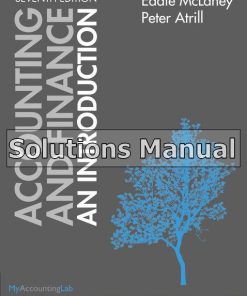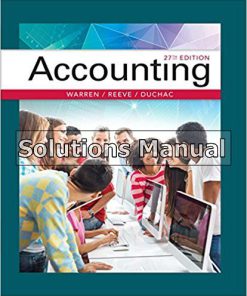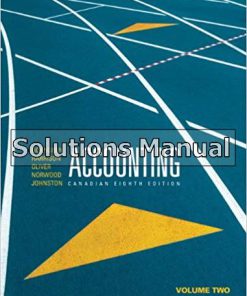Essential Statistics for the Behavioral Sciences 1st Edition Privitera Solutions Manual
$26.50$50.00 (-47%)
Essential Statistics for the Behavioral Sciences 1st Edition Privitera Solutions Manual.
You may also like
Essential Statistics for the Behavioral Sciences 1st Edition Privitera Solutions Manual

Product details:
- ISBN-10 : 9781483353005
- ISBN-13 : 978-1483353005
- Author: Gregory J. Privitera
Employing the hallmark pedagogical support of his successful comprehensive text, award-winning author, teacher, and advisor Gregory J. Privitera offers a brief and engaging introduction to the field with Essential Statistics for the Behavioral Sciences. Practical examples, integrated SPSS® coverage and screenshots, and numerous learning tools make intimidating concepts accessible. Students will welcome Privitera′s clear instruction, conversational voice, and application of statistics to current, real-life research problems.
Table contents:
- Chapter 1: Introduction to Statistics
- 1.1: The Use of Statistics in Science
- 1.2: Descriptive and Inferential Statistics
- 1.3: Research Methods and Statistics
- 1.4: Scales of Measurement
- 1.5: Types of Variables for Which Data Are Measured
- 1.6: Research in Focus: Evaluating Data and Scales of Measurement
- 1.7: SPSS in Focus: Entering and Defining Variables
- 1: End-of-Chapter Problems (7)
- 1: Test Bank (28)
- Chapter 2: Summarizing Data: Frequency Distributions in Tables and Graphs
- 2.1: Why Summarize Data?
- 2.2: Frequency Distributions for Grouped Data
- 2.3: Identifying Percentile Points and Percentile Ranks
- 2.4: SPSS in Focus: Frequency Distributions for Quantitative Data
- 2.5: Frequency Distributions for Ungrouped Data
- 2.6: Research in Focus: Summarizing Demographic Information
- 2.7: SPSS in Focus: Frequency Distributions for Categorical Data
- 2.8: Graphing Distributions: Continuous Data
- 2.9: Graphing Distributions: Discrete and Categorical Data
- 2.10: Research in Focus: Frequencies and Percents
- 2.11: SPSS in Focus: Histograms, Bar Charts, and Pie Charts
- 2: End-of-Chapter Problems (9)
- 2: Test Bank (27)
- Chapter 3: Summarizing Data: Central Tendency
- 3.1: Introduction to Central Tendency
- 3.2: Measures of Central Tendency
- 3.3: Characteristics of the Mean
- 3.4: Choosing an Appropriate Measure of Central Tendency
- 3.5: Research in Focus: Describing Central Tendency
- 3.6: SPSS in Focus: Mean, Median, and Mode
- 3: End-of-Chapter Problems (10)
- 3: Test Bank (28)
- Chapter 4: Summarizing Data: Variability
- 4.1: Measuring Variability
- 4.2: The Range and Interquartile Range
- 4.3: Research in Focus: Reporting the Range
- 4.4: The Variance
- 4.5: Explaining Variance for Populations and Samples
- 4.6: The Computational Formula for Variance
- 4.7: The Standard Deviation
- 4.8: What Does the Standard Deviation Tell Us?
- 4.9: Characteristics of the Standard Deviation
- 4.10: SPSS in Focus: Range, Variance, and Standard Deviation
- 4: End-of-Chapter Problems (11)
- 4: Test Bank (27)
- Chapter 5: Probability, Normal Distributions, and z Scores
- 5.1: Introduction to Probability
- 5.2: Calculating Probability
- 5.3: Probability and the Normal Distribution
- 5.4: Characteristics of the Normal Distribution
- 5.5: Research in Focus: The Statistical Norm
- 5.6: The Standard Normal Distribution and z Scores
- 5.7: A Brief Introduction to the Unit Normal Table
- 5.8: Locating Proportions
- 5.9: Locating Scores
- 5.10: SPSS in Focus: Converting Raw Scores to Standard z Scores
- 5: End-of-Chapter Problems (21)
- 5: Test Bank (30)
- Chapter 6: Characteristics of the Sample Mean
- 6.1: Selecting Samples From Populations
- 6.2: Selecting a Sample: Who’s In and Who’s Out?
- 6.3: Sampling Distributions: The Mean
- 6.4: The Standard Error of the Mean
- 6.5: Factors That Decrease Standard Error
- 6.6: SPSS in Focus: Estimating the Standard Error of the Mean
- 6.7: APA in Focus: Reporting the Standard Error
- 6.8: Standard Normal Transformations With Sampling Distributions
- 6: End-of-Chapter Problems (8)
- 6: Test Bank (28)
- Chapter 7: Hypothesis Testing: Significance, Effect Size, and Power
- 7.1: Inferential Statistics and Hypothesis Testing
- 7.2; Four Steps to Hypothesis Testing
- 7.3: Hypothesis Testing and Sampling Distributions
- 7.4: Making a Decision: Types of Error
- 7.5: Testing for Significance: Examples Using the z Test
- 7.6: Research in Focus: Directional Versus Nondirectional Tests
- 7.7: Measuring the Size of and Effect: Cohen’s d
- 7.8: Effect, Size, Power, and Sample Space
- 7.9: Additional Factors That Increase Power
- 7.10: SPSS in Focus: A Preview for Chapters 8 to 14
- 7.11: APA in Focus: Reporting the Test Statistic and Effect Size
- 7: End-of-Chapter Problems (7)
- 7: Test Bank (28)
- Chapter 8: Testing Means: One-Sample t Test With Confidence Intervals
- 8.1: Going From z to t
- 8.2: The Degrees of Freedom
- 8.3: Reading the t Table
- 8.4: Computing the One-Sample t Test
- 8.5: Effect Size for the One-Sample t Test
- 8.6: Confidence Intervals for the One-Sample t Test
- 8.7: Inferring Significance and Effect Size From a Confidence Interval
- 8.8: SPSS in Focus: One-Sample t Test and Confidence Intervals
- 8.9: APA in Focus: Reporting the t Statistic and Confidence Intervals
- 8: End-of-Chapter Problems (11)
- 8: Test Bank (28)
- Chapter 9: Testing Means: Two-Independent-Sample t Test With Confidence Intervals
- 9.1: Introduction to the Between-Subjects Design
- 9.2: Selecting Samples for Comparing Two Groups
- 9.3: Variability and Comparing Differences Between Two Groups
- 9.4: Computing the Two-Independent-Sample t Test
- 9.5: Effect Size for the Two-Independent-Sample t Test
- 9.6: Confidence Intervals for the Two-Independent-Sample t Test
- 9.7: Inferring Significance and Effect Size From a Confidence Interval
- 9.8: SPSS in Focus: Two-Independent-Sample t Test and Confidence Intervals
- 9.9: APA in Focus: Reporting the t Statistic and Confidence Intervals
- 9: End-of-Chapter Problems (6)
- 9: Test Bank (12)
- Chapter 10: Testing Means: Related-Samples t Test With Confidence Intervals
- 10.1: Related Samples Designs
- 10.2: Introduction to the Related-Samples t Test
- 10.3: Computing the Related-Samples t Test
- 10.4: Measuring Effect Size for the Related-Samples t Test
- 10.5: Confidence Intervals for the Related-Samples t Test
- 10.6: Inferring Significance and Effect Size From a Confidence Interval
- 10.7: SPSS in Focus: Related-Samples t Test and Confidence Intervals
- 10.8: APA in Focus: Reporting the t Statistic and Confidence Intervals
- 10: End-of-Chapter Problems (11)
- 10: Test Bank (31)
- Chapter 11: One-Way Analysis of Variance: Between-Subjects and Within-Subjects (Repeated-Measures) Designs
- 11.1: An Introduction to Analysis of Variance
- 11.2: The Between-Subjects Design for Analysis of Variance
- 11.3: Computing the One-Way Between-Subjects ANOVA
- 11.4: Post Hoc Tests: An Example Using Tukey’s HSD
- 11.5: SPSS in Focus: The One-Way Between-Subjects ANOVA
- 11.6: The Within-Subjects Design for Analysis of Variance
- 11.7: Computing the One-Way Within-Subjects ANOVA
- 11.8: Post Hoc Tests for the Within-Subjects Design
- 11.9: SPSS in Focus: The One-Way Within-Subjects ANOVA
- 11.10: A Comparison of Within-Subjects and Between-Subjects Designs for ANOVA: Implications for Power
- 11.11: APA in Focus: Reporting the Results of the One-Way ANOVAs
- 11: End-of-Chapter Problems (21)
- 11: Test Bank (49)
- Chapter 12: Two-Way Analysis of Variance: Between-Subjects Factorial Design
- 12.1: Introduction to Factorial Designs
- 12.2: Structure and Notation for the Two-Way ANOVA
- 12.3: Describing Variability: Main Effects and Interactions
- 12.4: Computing the Two-Way Between-Subjects ANOVA
- 12.5: Analyzing Main Effects and Interactions
- 12.6: Measuring the Effect Size for Main Effects and the Interaction
- 12.7: SPSS in Focus: The Two-Way Between-Subjects ANOVA
- 12.8: APA in Focus: Reporting the Results of the Two-Way ANOVAs
- 12: End-of-Chapter Problems (10)
- 12: Test Bank (28)
- Chapter 13: Correlation and Linear Regression
- 13.1: The Structure of Data Used for Identifying Patterns and Making Predictions
- 13.2: Fundamentals of the Correlation
- 13.3: The Pearson Correlation Coefficient
- 13.4: SPSS in Focus: Pearson Correlation Coefficient
- 13.5: Assumptions and Limitations for Linear Correlations
- 13.6: Alternatives to Pearson: Spearman, Point-Biserial, and Phi
- 13.7: SPSS in Focus: Computing the Alternatives to Pearson
- 13.8: Fundamentals of Linear Regression
- 13.9: Using the Method of Least Squares to Find the Regression Line
- 13.10: Using Analysis of Regression to Determine Significance
- 13.11: SPSS in Focus: Analysis of Regression
- 13.12: A Look Ahead to Multiple Regression
- 13.13: APA in Focus: Reporting Correlations and Linear Regression
- 13: End-of-Chapter Problems (21)
- 13: Test Bank (43)
- Chapter 14: Chi-Square Tests: Goodness-of-Fit and the Test for Independence
- 14.1: Distinguishing Parametric and Nonparametric Tests
- 14.2: The Chi-Square Goodness-of-Fit Test
- 14.3: SPSS in Focus: The Chi-Square Goodness-of-Fit Test
- 14.4: Interpreting the Chi-Square Goodness-of-Fit Test
- 14.5: The Chi-Square Test for Independence
- 14.6: Measures of Effect Size for the Chi-Square Test for Independence
- 14.7: SPSS in Focus: The Chi-Square Test for Independence
- 14.8: APA in Focus: Reporting the Chi-Square Tests
- 14: End-of-Chapter Problems (10)
- 14: Test Bank (28)
People also search:
essential statistics for the behavioral sciences
essential statistics for the behavioral sciences privitera pdf
fundamental statistics for the social and behavioral sciences 1st edition
what is behavioral science statistics
statistics for the behavioral sciences chapter 1 answers

